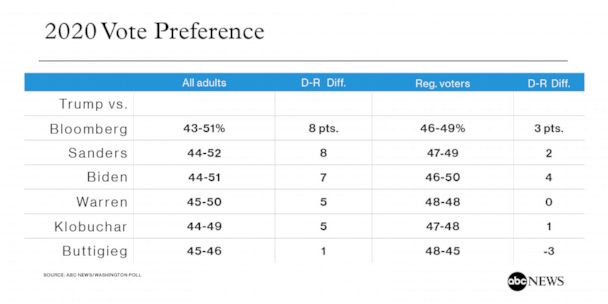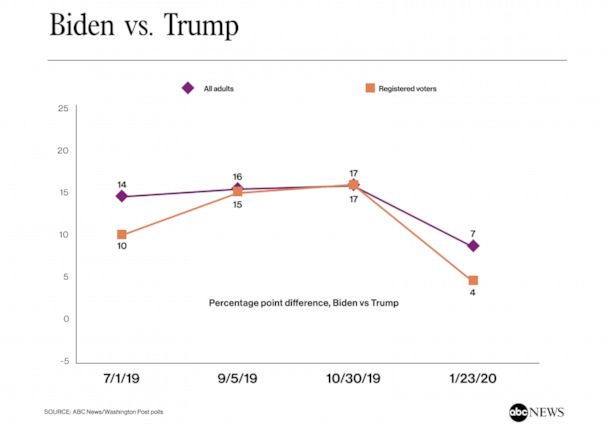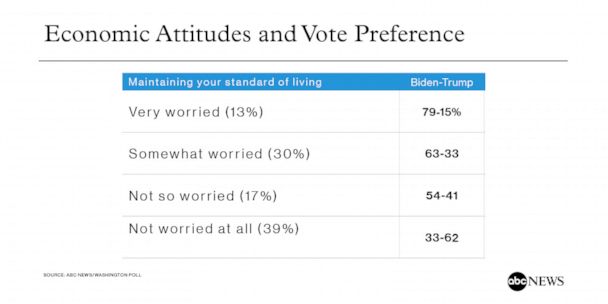Economic prosperity boosts Trump in election poll, counterweight to his unpopularity
Prosperity boosts Trump into a competitive position against potential opponents.
Economic prosperity is boosting Donald Trump's political prospects, helping the relatively unpopular president to a competitive position against his potential Democratic opponents in the fall election, the latest ABC News/Washington Post poll finds.
Key to Trump's opportunity is a rise in economic confidence. One year before he took office, 63% of Americans said they were worried about maintaining their standard of living. Today, 43% say so, a broad 20-point drop in personal economic uncertainty.
See PDF for full results, charts and tables.
Trump, moreover, gets a share of credit; as reported Friday, 56% approve of his handling of the economy, up 10 points since early September to a career high.
The result is a tighter contest for the presidency in this poll, produced for ABC News by Langer Research Associates. Among all adults, Trump trailed top Democratic candidates by double digits in the fall; he's now cut those margins in half. Among registered voters, moreover, he's now running essentially even in head-to-head matchups.
Registered voters divide closely, 50-46%, between Joe Biden and Trump, for example, compared with a 56-39% Biden lead three months ago. Among all adults, including those not registered, Biden's ahead, but now just by 7 points, 51-44%.
The story's similar for the other Democrats tested against Trump in this survey – Bernie Sanders, Elizabeth Warren, Mike Bloomberg, Pete Buttigieg and Amy Klobuchar. They range from 45 to 49% support among registered voters, while Trump has 46 to 48%. Among all adults, these Democrats range from 46 to 52% support; Trump, 43-45%.

In the table above, Bloomberg, Sanders and Biden have statistically significant leads against Trump among all adults. As noted, though, these are down from 17-point leads for Biden and Sanders alike last fall. (Bloomberg hadn't announced his candidacy at that time.)
Warren, Klobuchar and Buttigieg don't have significant leads vs. Trump among all adults; Warren and Buttigieg did in the fall. (Klobuchar wasn't tested.) And none of the Democratic candidates now has a significant lead among registered voters; in October, Biden, Sanders, Warren and Buttigieg all did.
Some of the latest results have been seen before; Trump also was even with Sanders, Warren and Buttigieg among registered voters last summer. But it's the first time Trump and Biden have been this close.

The economy's not the only factor. Among others, there's a vast gender gap: The Democratic candidates tested in this poll lead Trump by 23 to 30 percentage points among women, while Trump leads by 15 to 24 points among men. If it held on Election Day, it'd nearly double the previous record gender gap in exit polls dating to 1976, 24 points in 2016,
Expectations/Enthusiasim
Trump moves slightly ahead in another measure, albeit a speculative one: Americans by 49-43% say they expect him to win reelection. Of course, that doesn't always work out; during the 2016 election cycle, half or more expected Hillary Clinton to win.
A measure of enthusiasm, which can indicate motivation to vote, also is somewhat better for Trump. Ninety-three percent of people who back him in all these matchups say they're enthusiastic about supporting him, while fewer of those who always pick the Democratic candidates say they're enthusiastic about opposing Trump, 81%.
Still, while negative enthusiasm – opposing Trump – is one factor, another remains to be seen: whether the party's eventual candidate can generate positive enthusiasm at or above the levels the president now enjoys.
Approval and the Economy
Competing fundamentals are at play in the election. At 44-51%, Trump's job approval rating – even as it matches his career high – is short of the level often associated with re-election. George Bush had 46% approval at about this point in 1992; he continued down from there, and lost. In Gallup data, Jimmy Carter had 58% approval in January 1980, but he, too, fell steadily from there, and likewise lost. Gerald Ford was at 45% in January 1976, on the way to his retirement.
Further, Trump, as reported Friday, has the lowest career average approval of any president in 75 years of modern polling, and is the first never to achieve majority approval.
That said, Bush, Carter and Ford faced stiff economic headwinds in their re-election campaigns, and their approval was falling or flat as the election approached; Trump, by contrast, has an economic tailwind. (And there's another case, Barack Obama in 2012; he started the year at 48% approval and barely made 50% in the months ahead, yet won re-election with 51% of the popular vote.)

Demonstrating the impact of economic attitudes, Trump's job approval rating is just 26% among Americans who are very or somewhat worried about maintaining their standard of living, but jumps to 59% among those who are not so or not at all worried. And the less-worried group, as noted, is the bigger one, 56% of the public, up from 37% four years ago.
This is apparent in vote preferences as well as approval. Tested against Biden, Trump has 56% support among those who are less worried or unworried about maintaining their standard of living, vs. 27% support among those who are more worried.
Degrees of worry matter, as well. Trump's support against Biden reaches 62% among the plurality of Americans who are entirely unworried about maintaining their standard of living. It drops to 41% among those who are "not so" worried and 33% among those who are somewhat worried, and bottoms out at 15% among the very worried. Results are similar measuring Trump against the other Democratic candidates tested in this survey.

Partisanship, to be sure, is related to economic worry; people who are skeptical of the person at the nation's helm are less confident. Among Democrats, 57% are very or somewhat worried about being able to maintain their current standard of living; among Republicans, this plummets to 27%. Notably, it's 40% among independents, the swing voters in many elections; 59% of independents express little or no worry about their economic stability.
It's true, too, that Democrats include more economically vulnerable groups -- lower-income adults, women, and racial or ethnic minorities all are more apt to identify themselves as Democrats than as Republicans.
For all this, Trump does have vulnerabilities on the economy. As shown, he leads only among those who are not at all worried about maintaining their standard of living. And his 56% approval rating on the economy pales in comparison to Bill Clinton's high on this measure in the last go-go economy; Clinton's approval rating for handling the economy reached as high as 76% in ABC/Post polls.
Support Groups
As is the case with Trump's approval rating, there are vast differences among groups in support for Trump vs. his potential Democratic opponents. We use Biden as an example in the results that follow; findings are generally similar for the other top Democrats.
Men divide 56-39% in favor of Trump vs. Biden; women, 62-32% for Biden – a vast 47-point gender gap, twice as big as it was in the 2016 election, per the national exit poll. Trump won 52% of men in that contest, while Hillary Clinton won 54% of women.

The split is even bigger in the suburbs: Suburban men take Trump over Biden by 63-35%, while it's the opposite among suburban women. They support Biden by 68-30%, producing a remarkable 66-point gender gap.
Among other groups, 87% of Republicans pick Trump and 93% of Democrats favor Biden, while independents divide essentially evenly. Biden prevails among moderates (59-36%) and liberals (84-12%) alike, while Trump comes back with a 71-26% advantage among conservatives (who outnumber liberals by 15 points).
Trump retains support from 94% of those who say they voted for him in 2016.
Trump leads Biden by 54-42% among whites, a group Trump won by 57-37% in 2016. This includes 58-40% result among white Catholics and a vast 80-18% among evangelical white Protestants (similar to Trump's margin among white evangelicals in 2016). Among non-evangelical white Protestants, the race goes to essentially a dead heat, 48-46%.
Biden has almost unanimous support from blacks (94-4%) and nearly a 2-to-1 lead among Hispanics (61-31%). The latter is somewhat below Democrats' performance among Hispanics in exit polls the last three presidential elections (67% in 2016, 71% in 2012 and 67% in 2008).
Biden also underperforms recent history with voters in union households. This group -- 12% of the population -- divides closely, 49-45%, Biden-Trump, a 4-point margin. Democratic presidential candidates won union household voters by 9 points in 2016 and by wider margins, 18 to 22 points, from 2000 to 2012.
Methodology
This ABC News/Washington Post poll was conducted by landline and cellular telephone Jan. 20-23, 2020, in English and Spanish, among a random national sample of 1,004 adults. Results have a margin of sampling error of 3.5 points, including the design effect. Partisan divisions are 27-24-39%, Democrats-Republicans-independents.
The survey was produced for ABC News by Langer Research Associates of New York, New York, with sampling and data collection by Abt Associates of Rockville, Maryland. See details on the survey's methodology here.